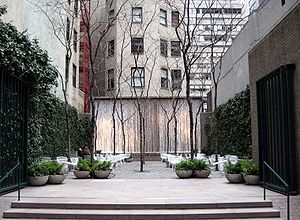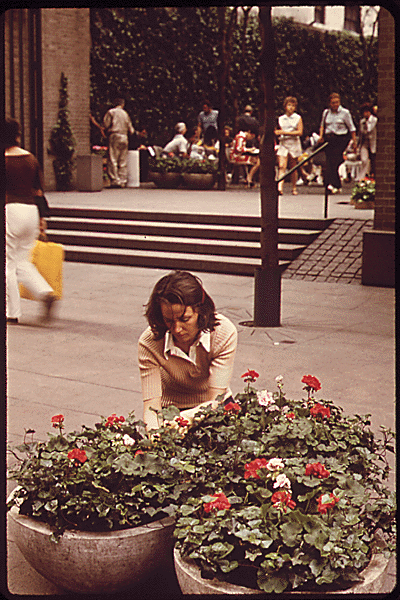
Paley Park
Encyclopedia

Pocket park
A pocket park, parkette or mini-park is a small park accessible to the general public. In some areas they are called miniparks or vest-pocket parks....
located at 3 East 53rd Street
53rd Street (Manhattan)
53rd Street is a midtown cross street in the New York City borough of Manhattan, that contains buildings such as the Citicorp Building. It is 1.83 miles long. The street runs westbound from Sutton Place across most of the island's width, ending at DeWitt Clinton Park at Eleventh Avenue...
in Midtown Manhattan
Midtown Manhattan
Midtown Manhattan, or simply Midtown, is an area of Manhattan, New York City home to world-famous commercial zones such as Rockefeller Center, Broadway, and Times Square...
on the former site of the Stork Club
Stork Club
The Stork Club was a nightclub in New York City from 1929 to 1965. From 1934 onwards, it was located at 3 East 53rd Street, just east of Fifth Avenue...
. Designed by the landscape architectural firm of Zion & Breen, it opened May 23, 1967 on the former site of the Stork Club
Stork Club
The Stork Club was a nightclub in New York City from 1929 to 1965. From 1934 onwards, it was located at 3 East 53rd Street, just east of Fifth Avenue...
. Paley Park is often cited as one of the finest urban spaces in the United States.
Measuring 4200 square feet (390.2 m²), the park offers a quiet urban oasis in the midst of the bustling city by the careful use of falling water, airy trees, lightweight furniture and simple spatial organization.
Key to its success is a 20 feet (6.1 m) high waterfall spanning the entire back of the park. The waterfall creates a backdrop of grey noise
Grey noise
Grey noise is random noise subjected to a psychoacoustic equal loudness curve over a given range of frequencies, giving the listener the perception that it is equally loud at all frequencies....
to mask the sounds of the city. The park is surrounded by walls on three sides and is open to the street (with an ornamental gate) on the fourth side, facing the street. The walls are covered in ivy, and the overhead canopy formed by locust trees adds a degree of serenity to the park.

William S. Paley
William S. Paley was the chief executive who built Columbia Broadcasting System from a small radio network into one of the foremost radio and television network operations in the United States.-Early life:...
Foundation and was named by Paley for his father, Samuel Paley. A plaque near the entrance reads:
- This park is set aside in memory of Samuel Paley, 1875-1963, for the enjoyment of the public.
Social interaction in the park was analyzed in the film "The Social Life of Small Urban Spaces" by William H. Whyte
William H. Whyte
William Hollingsworth "Holly" Whyte was an American urbanist, organizational analyst, journalist and people-watcher.Whyte was born in West Chester, Pennsylvania in 1917 and died in New York City in 1999. An early graduate of St. Andrew's School in Middletown, Delaware, he graduated from Princeton...
.
Architectural features
A wheelchair ramp is positioned on either side of the four steps that lead into the park which is elevated from the sidewalk level. The park displays a unique blend of synthetic materials, textures, colors and sounds. The wire mesh chairs and marbleMarble
Marble is a metamorphic rock composed of recrystallized carbonate minerals, most commonly calcite or dolomite.Geologists use the term "marble" to refer to metamorphosed limestone; however stonemasons use the term more broadly to encompass unmetamorphosed limestone.Marble is commonly used for...
tables are light and don't detract from the surroundings. The ground pavement is not terrazzo
Terrazzo
Terrazzo is a composite material poured in place or precast, which is used for floor and wall treatments. It consists of marble, quartz, granite, glass or other suitable chips, sprinkled or unsprinkled, and poured with a binder that is cementitious, chemical or a combination of both...
or concrete but features rough-hewn stone tiles. The honey locust
Honey locust
The Honey locust, Gleditsia triacanthos, is a deciduous tree native to central North America. It is mostly found in the moist soil of river valleys ranging from southeastern South Dakota to New Orleans and central Texas, and as far east as eastern Massachusetts.-Description:Honey locusts, Gleditsia...
trees were planted at 12 feet (3.7 m) intervals. The green of the ivy-covered wall contrasts with colorful flowers, and the white waterfall, cascading at 1800 gallons per minute, creates a sound barrier to the noise from the street.
Paley Park is located one-and-a-half blocks from The Paley Center for Media, which was next door to the park (as the Museum of Broadcasting) before moving to its present location.
Further reading
Privately Owned Public Space: "The New York City Experience" by Jerold S. KaydenTate, Alan. "Great City Parks" Spon Press, London, (2001) ISBN 0419244204

